Natal Stones
Sentiments and Superstitions Associated with Precious Stones
by George Frederick Kunz
With Pala Presents, we offer selections from the library of Pala International’s Bill Larson, who shares with us some of the wealth of information in the realm of gems and gemology. The following edition of this book was first published by Tiffany & Co. in 1909. Illustrations are taken from Pala International’s Featured Stones.
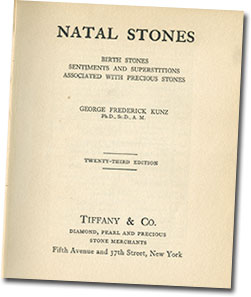 |
The Jewish superstitions relating to gems were probably derived from earlier races and adopted by the Arabian philosophers in their works, by which they became known throughout Europe. The influence of gems was believed in until early in the 17th century, and in regard to some gems up even to the present century.
The association of a special gem with each month was probably suggested by the original breastplate of the High Priest, which contained twelve gems, one for each of the tribes of Israel. The original breastplate was a span long and a span high: 1 span = 8 inches. The arrangement by months came in vogue during the 15th and 16th centuries, but was first suggested in the seventh century, although it is attributed to the Jews, Romans, and early Arabians.
Aaron’s Breastplate |
||
| 3 Emerald |
2 Peridot |
1 Carnelian |
| 6 Onyx |
5 Lapis-lazuli |
4 Ruby |
| 9 Quartz |
8 Agate |
7 Sapphire |
| 12 Jasper |
11 Beryl |
10 Topaz |
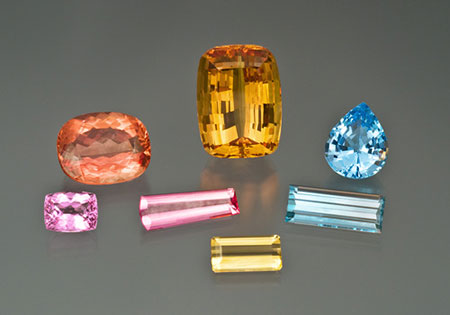 |
| Topaz suite – November’s natal stone: Pink cushion 4.97 ct (Inventory #17535), imperial cushion 22.49 ct (Inventory #17513), rose tapered emerald cut 4.76 ct (sold), golden cushion 53.80 ct (Inventory #1643), yellow emerald cut 4.11 ct (Inventory #5070), light blue emerald cut 9.76 ct (Inventory #8679), blue pear shape 10.74 ct (not inventoried). (Photo: Mia Dixon) |
Natal Stones of Various Nations and Periods |
||||||||
| Month | Jews | Romans | 635 A.D. Isidorus, Bishop of Seville |
Arabians | Poles | Russians | Italians | 18th to 20th Century |
| Jan. | Garnet | Garnet | Hyacinth | Garnet | Garnet | Garnet Hyacinth |
Jacinth Garnet |
Hyacinth Garnet |
| Feb. | Amethyst | Amethyst | Amethyst | Amethyst | Amethyst | Amethyst | Amethyst | Amethyst Hyacinth Pearl |
| Mch. | Jasper | Bloodstone | Jasper | Bloodstone | Bloodstone | Jasper | Jasper | Jasper Bloodstone |
| April | Sapphire | Sapphire | Sapphire | Sapphire | Diamond | Sapphire | Sapphire | Diamond Sapphire |
| May | Chalcedony Carnelian Agate |
Agate | Agate | Emerald | Emerald | Emerald | Agate | Emerald Agate |
| June | Emerald | Emerald | Emerald | Agate Chalcedony Pearl |
Agate Chalcedony |
Agate Chalcedony |
Emerald | Cats-Eye Emerald Turquoise Agate |
| July | Onyx | Onyx | Onyx | Carnelian | Ruby | Ruby Sardonyx |
Onyx | Turquoise Onyx |
| Aug. | Carnelian | Carnelian | Carnelian | Sardonyx | Sardonyx | Alexandrite | Carnelian | Sardonyx Carnelian Moonstone Topaz |
| Sept. | Chrysolite | Sardonyx | Chrysolite | Chrysolite | Sardonyx | Chrysolite | Chrysolite | Beryl Chrysolite |
| Oct. | Aquamarine Beryl | Aquamarine Beryl | Aquamarine Beryl | Aquamarine Beryl | Aquamarine Beryl | Beryl | Beryl | Aquamarine Beryl Pearl |
| Nov. | Topaz | Topaz | Topaz | Topaz | Topaz | Topaz | Topaz | Topaz Pearl |
| Dec. | Ruby | Ruby | Ruby | Ruby | Turquoise | Turquoise Chrysoprase |
Ruby | Ruby Bloodstone |
Sentiments Associated with Stones |
|
| Agate | Health, Wealth and Longevity. |
| Alexandrite | Undying Devotion. |
| Amethyst | Deep Love. Prevents Intoxication. |
| Beryl | Happiness and Everlasting Youth. |
| Bloodstone | Courage and Wisdom. |
| Carnelian | Prevents Misfortune. |
| Cat’s-eye | Warns of Danger and Troubles. |
| Chalcedony | Disperses Melancholy. |
| Chrysolite | Gladdens the Heart. |
| Chrysoprase | Eloquence. |
| Diamond | Purity. Preserves Peace. Prevents Storms. |
| Emerald | Immortality. Conquers Sin and Trial. |
| Garnet | Insures Power, Grace and Victory to the Wearer. |
| Hyacinth | Gives Second Sight. |
| Jacinth | Modesty. |
| Jade | Good Fortune. |
| Jasper | Courage and Wisdom. |
| Moonstone | (Sacred Stone of the Orient.) Good Luck. |
| Onyx | Conjugal Felicity |
| Opal | Hope, Innocence, Purity. |
| Pearl | Purity and Innocence. |
| Ruby | Charity, Dignity and Divine Power. |
| Sapphire | Constancy, Truth and Virtue. |
| Sardonyx | Conjugal Felicity. Prevents Misfortune. |
| Topaz | Friendship and Fidelity. |
| Turquoise | Prosperity. Soul-cheerer. |
Sentiments of the Months
January
- Natal Stone Garnet.
- Guardian Angel Gabriel.
- His Talismanic Gem Onyx.
- Special Apostle Simon Peter.
- Zodiacal Sign Aquarius.
- Flower
Snowdrop.
No gems save garnets should be worn
By her who in this month is born;
They will insure her constancy,
True friendship and fidelity.The gleaming garnet holds within its sway
Faith, constancy and truth to one alway.
February
- Natal Stone Amethyst.
- Guardian Angel Barchiel.
- His Talismanic Gem Jasper.
- Special Apostle Andrew.
- Zodiacal Sign Pisces.
- Flower
Primrose.
The February-born may find
Sincerity and peace of mind,
Freedom from passion and from care,
If she an amethyst will wear.Let her an amethyst but cherish well
And strife and care can never with her dwell.
March
- Natal Stones Jasper, Bloodstone.
- Guardian Angel Malchediel.
- His Talismanic Gem Ruby.
- Special Apostle James and John.
- Zodiacal Sign Aries.
- Flowers
Ipomœa, Violet.
Who on this world of ours her eyes
In March first opens may be wise,
In days of peril firm and brave,
Wears she a bloodstone to her grave.Who wears a jasper, be life short or long,
Will meet all dangers, brave and wise and strong.
April
- Natal Stones Diamond, Sapphire.
- Guardian Angel Ashmodei.
- His Talismanic Gem Topaz.
- Special Apostle Philip.
- Zodiacal Sign Taurus.
- Flower
Daisy.
She who from April dates her years
Diamonds should wear, lest bitter tears
For vain repentance flow. This stone
Emblem of innocence is known .Innocence, repentance—sun and shower——
The diamond or the sapphire is her dower.
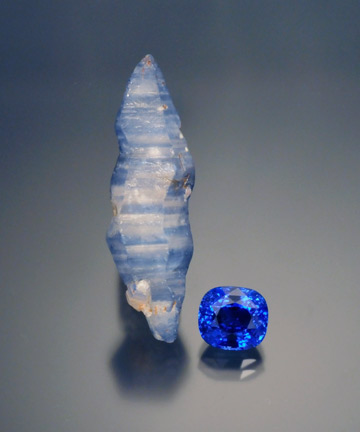 |
| Sri Lankan sapphire pair. The crystal measures 4.3 x 1.3 cm. and weighs 48.23 cts. The faceted gem measures 10.48 x 9.56 x 7.3 mm., weighs 7.13 cts., and is certified natural color from Sri Lanka. Search for the cut stone on inventory number 14737. |
May
- Natal Stone Emerald.
- Guardian Angel Amriel.
- His Talismanic Gem Carbuncle.
- Special Apostle Bartholomew.
- Zodiacal Sign Gemini.
- Flower
Hawthorn.
Who first beholds the light of day
In spring’s sweet, flow’ry month of May
And wears an emerald all her life
Shall be a loved and happy wife.No happier wife and mother in the land
Than she with emerald shining on her hand.
June
- Natal Stone Agate.
- Guardian Angel Muriel.
- His Talismanic Gem Emerald.
- Special Apostle Thomas.
- Zodiacal Sign Cancer.
- Flower
Honeysuckle.
Who comes with summer to this earth,
And owes to June her hour of birth,
With ring of agate on her hand
Can health, long life and wealth command.Thro’ the moss-agate’s charm, the happy years
Ne’er see June’s golden sunshine turn to tears.
July
- Natal Stone Turquoise.
- Guardian Angel Verchiel.
- His Talismanic Gem Sapphire.
- Special Apostle Matthew.
- Zodiacal Sign Leo.
- Flower
Water-lily.
The heav’n-blue turquoise should adorn
All those who in July are born;
For thus they’ll be exempt and free
From love’s doubts and anxiety.No other gem than turquoise on her breast
Can to the loving, doubting heart bring rest.
August
- Natal Stone Carnelian.
- Guardian Angel Mamatiel.
- His Talismanic Gem Diamond.
- Special Apostle James, the son of Alpheus.
- Zodiacal Sign Virgo.
- Flower
Poppy.
Wear a carnelian or for thee
No conjugal felicity
The August-born without this stone
’Tis said, must live unloved, alone.She, loving once and always, wears, if wise
Carnelian—and her home is paradise.
September
- Natal Stone Chrysolite.
- Guardian Angel Tsuriel.
- His Talismanic Gem Jacinth.
- Special Apostle Lebbeus Thaddeus.
- Zodiacal Sign Libra.
- Flower
Morning-glory.
A maid born when September leaves
Are rustling in the autumn breeze,
A chrysolite on brow should bind——
’Twill cure diseases of the mind .If chrysolite upon her brow is laid,
Follies and dark delusions flee afraid.
October
- Natal Stone Beryl.
- Guardian Angel Bariel.
- His Talismanic Gem Agate.
- Special Apostle Simon. (Zelotes.)
- Zodiacal Sign Scorpio.
- Flower
Hops.
October’s child is born for woe,
And life’s vicissitudes must know;
But lay a beryl on her breast,
And Hope will lull those woes to rest.When fair October to her brings the beryl,
No longer need she fear misfortune’s peril.
November
- Natal Stone Topaz.
- Guardian Angel Adnachiel.
- His Talismanic Gem Amethyst.
- Special Apostle Matthias.
- Zodiacal Sign Sagittarius.
- Flower
Chrysanthemum.
Who first comes to this world below
With drear November’s fog and snow
Should prize the topaz’ amber hue——
Emblem of friends and lovers true.Firm friendship is November’s, and she bears
True love beneath the topaz that she wears.
December
- Natal Stone Ruby.
- Guardian Angel Humiel.
- His Talismanic Gem Beryl.
- Special Apostle Paul.
- Zodiacal Sign Capricornus.
- Flower
Holly.
If cold December give you birth—
The month of snow and ice and mirth—
Place on your hand a ruby true;
Success will bless whate’er you do.December gives her fortune, love and fame
If amulet of rubies bear her name.
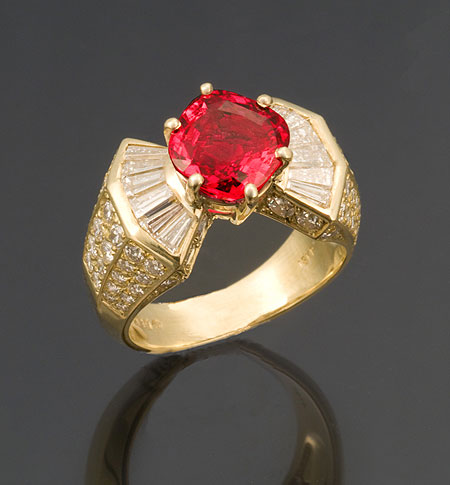 |
| This 3.18-carat ruby—December’s natal stone—demonstrates the limpid yet lively quality of this Winza, Tanzania material. (Photo: Mia Dixon) |
Acrostics Formed with Stones
In France and England, during the 18th century, rings, bracelets, brooches, etc., were often set with gems the first letters of which, combined, formed a motto or expressed a sentiment. The following is a list of those that may be used in this way. The gems in the first column are the more expensive ones, those in the second column the inexpensive ones.
FAITH |
HOPE |
CHARITY |
|||||
| Fire-opal. Alexandrite. lolite. Tourmaline. Hyacinth. |
Feldspar. Amethyst. Idocrase. Topaz. Heliotrope. |
Hyacinth. Opal. Pearl. Emerald. |
Hematite. Olivine. Pyrope. Essonite. |
Carbuncle. Hematite. Amethyst. Rose quartz. Idocrase. Topaz. Yu (Jade). |
Cat’s-eye. Hyacinth. Aquamarine. Ruby. lolite. Tourmaline. Yellow sapphire. |
||
GOOD LUCK |
FOREVER |
REGARD |
|||||
| Golden beryl. Opal. Olivine. Diamond. Lapis-lazuli. Uralian emerald. Cat’s-eye. Kyanite. |
Garnet. Onyx. Obsidian. Dendrite. Labradorite. Unio pearl. Carnelian. Krokydolite. |
Fire-opal. Opal. Ruby. Emerald. Vermeille. Essonite. Rubellite. |
Flèches d’amour. Onyx. Rutile. Essonite. Verd antique. Epidote. Rose quartz. |
Ruby. Emerald. Garnet. Alexandrite. Ruby. Diamond. |
Rubellite. Essonite. Garnet. Amethyst. Rock-crystal. Demantoid. |
||
DEAREST |
SOUVENIR |
BONHEUR |
|||||
| Diamond. Emerald. Alexandrite. Ruby. Essonite. Sapphire. Turquoise. |
Demantoid. Essonite. Amethyst. Rubellite. Epidote. Spinel. Topaz. |
Sapphire. Opal. Uralian emerald. Vermeille. Emerald. Nephrite. Iolite. Ruby. |
Sunstone. Onyx. Utahlite. Verd antique. Epidote. Nephrite. Indicolite. Rock-crystal. |
Beryl. Opal. Nephrite. Hyacinth. Emerald. Uralian emerald. Ruby. |
Bloodstone. Onyx. Nephrite. Hematite. Essonite. Utahlite. Rhodonite. |
||
AMITIE |
LOVE ME |
A E I Greek, “forever,” “eternity” |
|||||
| Alexandrite. Moonstone. Indicolite. Tourmaline. Idocrase. Emerald. |
Almandine. Moonstone. Indicolite. Topaz Idocrase. Essonite. |
Lapis-lazuli. Opal. Vermeille. Emerald. Moonstone. Essonite. |
Labrador spar. Onyx. Verd antique. Essonite. Moonstone. Epidote. |
Alexandrite. Emerald. Indicolite. |
Almandine. Essonite. Idocrase. |
||
Z E S Greek, “Mayest thou live.” |
MIZPAH |
FRIENDSHIP |
|||||
| Zircon. Emerald. Sapphire. |
Zonochlorite. Essonite. Sard. |
Moonstone. Indicolite. Zircon. Peridot. Asteria. Hyacinth. |
Moldavite. Idocrase. Zonochlorite. Pyrope. Aquamarine. Hematite. |
Flèches d’amour. Ruby. Indicolite. Emerald. Nephrite. Diamond. Sapphire. Hyacinth. Iolite. Pearl. |
Feldspar. Bock crystal. Idocrase. Epidote. Nicolo. Diopside. Sard. Hematite. ldocrase. Pyrite. |
||
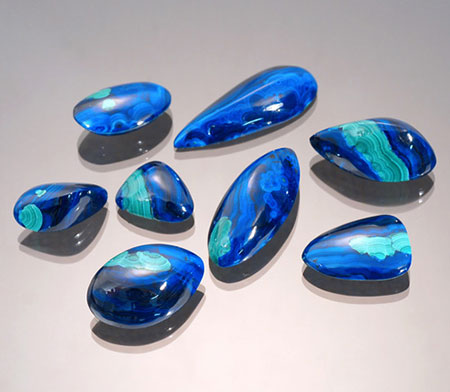 |
| Azurite-Malachite from Arizona. Various shapes and sizes. For reference the bullet shaped stone at lower right is 11 ct, 18.66 x 14 x 5.11 mm, Inventory #16149. Click to enlarge. (Photo: Wimon Manorotkul) |
State Stones
Precious, semi-precious or gem stones are found in nearly all the United States. The most important are enumerated below:
| Alabama | Beryl, blue and yellow; smoky quartz. |
| Arizona | Agatized wood, azur-malachite, turquoise, garnet., peridot. |
| Arkansas | Rock crystal, smoky quartz, agate, novaculite. |
| California | Agate, benitoite, californite, diamond, gold quartz, tourmaline, abalone pearl, chrysoprase, kunzite. |
| Colorado | Beryl, aquamarine, phenacite, garnet, amethyst, agate, gold quartz, pyrite. |
| Connecticut | Beryl, yellow and green; rose quartz; tourmaline. |
| Delaware | Pearl. |
| Florida | Chalcedony, conch pearl. |
| Georgia | Ruby, beryl, amethyst, gold quartz, garnet. |
| Idaho | Opal, agate, obsidian. |
| Illinois | Fluorite, pearl. |
| Indian Territory | Obsidian, pearl. |
| Indiana | Pearl. |
| Iowa | Fossil coral, pearl, chalcedony. |
| Kansas | Chalcedony. |
| Kentucky | Pearl. |
| Louisiana | Chalcedony. |
| Maryland | Beryl, clam-pearl. |
| Massachusetts | Beryl. |
| Maine | Tourmaline, beryl, rose quartz, pearl, topaz, amazonite, smoky quartz, rock crystal. |
| Michigan | Agate, hematite. |
| Minnesota | Chlorastrolite, thomsonite, agate. |
| Mississippi | Pearl, chalcedony. |
| Missouri | Pearl, fluorite, pyrite. |
| Montana | Sapphire, beryl, smoky quartz, agate, amethyst, agatized wood, obsidian. |
| Nebraska | Chalcedony, pearl. |
| Nevada | Gold quartz, rock crystal. |
| New Hampshire | Beryl, rock crystal, garnet. |
| New Jersey | Fowlerite, willemite, prehnite, smoky quartz, agate, pearl. |
| New Mexico | Turquoise, garnet., obsidian, peridot, rock crystal. |
| New York | Beryl, brown tourmaline, rose quartz, fresh-water pearl, clam-pearl, chondrodite. |
| North Carolina | Aquamarine, beryl, emerald, almandite garnet., rhodolite, pyrope garnet, diamond, cyanite, hiddenite, amethyst, ruby, sapphire, smoky quartz, rock crystal, rutile. |
| North Dakota | Chalcedony, agate. |
| Ohio | Fossil coral, chalcedony. |
| Oregon | Agate, obsidian, hydrolite. |
| Pennsylvania | Amethyst, beryl, sunstone, moonstone, amazonite, almandite garnet., pyrope garnet. rutile. |
| Rhode Island | Hornblende in quartz, amethyst, rock crystal. |
| South Carolina | Beryl, smoky quartz, rock crystal. |
| South Dakota | Quartzite, beryl, agate. |
| Tennessee | Pearl. |
| Texas | Beryl, pearl. |
| Utah | Topaz, garnet. |
| Vermont | Beryl, pearl. |
| Virginia | Amethysts, spessarite, garnet., beryl, moonstone, staurolite. allanite. |
| Washington | Pearl, agate. |
| West Virginia | Rock crystal. |
| Wisconsin | Agate, pearl. |
| Wyoming | Moss-agate, agate. |
Precious and Semi-Precious Stones
Unmounted Stones and Notable Collections.
Tiffany & Co.’s connections in many different countries and their facilities for securing the choicest gems from first hands, enable them to maintain the most comprehensive stock and to offer patrons many other advantages not obtainable elsewhere.
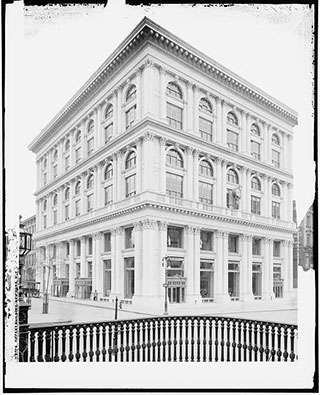 |
| The Tiffany Building, New York, not long after the publication of G. F. Kunz’s Natal Stones. (Photo: Detroit Publishing Co., Library of Congress) |
With their expert precious stone and gem lapidaries, as well as gem engravers, they are in a position to recut gems for matching chipped or poorly cut diamonds or other gems, and also to cut or recut any precious stone or gem directly from the rough; to engrave crests, monograms or other devices on sapphires, alexandrites, topaz, bloodstone, sard or other stones for seals or signet rings, or to execute, to special order, caskets, vinaigrettes, or other objects of rock crystal, jade and other hard stones.
The vigilant scrutiny constantly employed absolutely guards against the admission of any inferior stones to their stock.
Some collections of veritable antique intaglios and scarabæi engraved on sards, carnelians, chalcedonies, bloodstones, garnets, or other gems, all obtained from either well-known collectors or authorities.
Carbon, carbonado or bort from Brazil for diamond drills and mining operations, in quantities of few carats up to parcels containing thousands of carats.
The gems of the birth-month are frequently mounted into rings, charms, and other devices, with the zodiacal signs wrought into the settings, also the flower of the month, etc.
Collections:
The following are among the notable collections of precious and semi-precious stones prepared by Tiffany & Co. for International Expositions.
1915 San Francisco, California, Mines and Mining Building, Panama-Pacific Exposition collection.
1907 Jamestown Exposition Collection, Gold Medal.
1905 Portland, Oregon, Exposition collection, awarded two gold medals.
1904 St. Louis Exposition collection. Grand Prize.
1902 Turin Exposition collection, Hors Concours, awarded special diploma of merit.
1901 Buffalo Exposition collection, awarded gold medal, presented by the late J. Pierpont Morgan, Esq., to the Musee Histoire Naturelles, Jardin des Plantes, Paris.
1900 Paris Exposition collection, awarded the Grand Prix, and was presented by the late J. Pierpont Morgan, Esq., to the American Museum of Natural History, New York.
1895 Atlanta Exposition collection, presented by Dr. L. T. Chamberlain to the United States National Museum, Washington.
1894 special collection, purchased by the Midwinter Fair Memorial Museum of San Francisco.
1893 Chicago Exposition collection received several special awards, and was purchased by the “Field Columbian Museum,” Chicago.
1889 Paris Exposition collection awarded two gold and one silver medals, was presented by the late J. Pierpont Morgan, Esq., to the American Museum of Natural History, New York.
1878 Paris Exposition collection, awarded the Grand Prix.
1867 Paris Exposition, awarded a gold medal.
Unmounted Stones
Tiffany & Co.’s stock of unmounted stones includes the following:
Phenomenal Gems
Chrysoberyl Cat’s-eye, Alexandrite Cat’s-eye, Alexandrite, Ruby and Sapphire Asteria, Moonstone—with light blue and white chatoyancy.
Alexandrite
Leaf or olive green by natural or day-light, and columbine or raspberry red by artificial light, from Ceylon and Takawaja, Asiatic Russia.
Amethyst
Rich royal purple, from the Ural Mountains and Auvergne, France. Red by artificial light, from the Ural Mountains, Fine purple from Brazil, South America, North Carolina, and Virginia.
Aquamarine
Deep blue, from Brazil; green and blue. from Connecticut, the Ural Mountains, Siberia, and North Carolina; light blue and light green, from California and Maine.
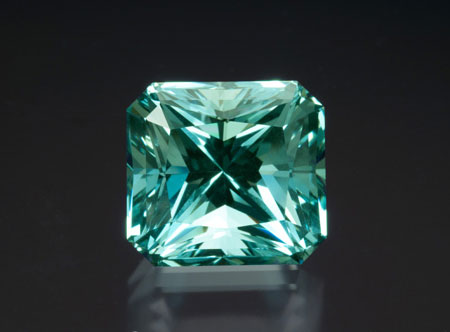 |
| A flawless 22-carat natural aquamarine, October’s natal stone, with an exquisite radiant-style faceting. This stone has been sold. (Photo: MIa Dixon) |
Asteria
Light blue, blue, purple, light red, and ruby red, from Ceylon and Burmah.
Azur-Malachite
Blue and green mixture. Arizona.
Benitoite
Blue, from California.
Beryl
Light blue and green, from Maine, North Carolina, Connecticut, Colorado. Brazil, and Siberia. Deep blue, from California, North Carolina and Brazil. Yellow, and yellow Ural Mountains, and Siberia. Rose, Madagascar and California.
Californite
California.
Chlorastrolite
From Isle Royal, Lake Superior. Chrysoberyl Light yellow, golden yellow, yellow brown, yellowish green, sage green, green, olive green, from Brazil and Ceylon.
Chrysoberyl Cat’s-eye
Light yellow. yellow, yellowish brown, and green, from Brazil an Ceylon. Also Alexandrite Cat’s-eyes, green by day and red by night, from Ceylon.
Chrysocolla
Sky blue, Arizona.
Diamond
From India, Brazil, and South Africa. White. steel blue, rose colored, lemon and orange, yellow, cinnamon, light green, brown black, and a large assortment of rare and curious tints, from which material for a necklace, brooch, ring, or other jewel can be selected.
Emerald
Rich velvet and grass-green, from the Muso mine, New Granada. Light green from Takawaja, Asiatic Russia, and New South Wales.
Essonite
Or Hyacinths, from Ceylon.
Garnet
Rich red, almost ruby red, from Arizona, New Mexico, and South Africa. Purple and almandine, from India and Bohemia. Honey yellow (essonite or hyacinth variety), from Ceylon. Honey brown, reddish brown (spessartite variety), from Virginia. Green (demantoid variety), rich, vivid green, green, yellow green, from the Ural Mountains.
Jade
Under this name two entirely distinct mineral substances are used in the arts. Jade or Nephrite is 6.5 in hardness, and is one of the toughest minerals known. It is a silicate of magnesia with a schistose and often a felt-like structure. It has a specific gravity of about 2.9; occurs in various shades of green, also white, and can be highly polished. This mineral is often found in large pieces. A waterworn boulder found in western New Zealand weighs 7,500 lbs. It was purchased by Tiffany & Co., and is now in possession of the American Museum of Natural History. Nephrite is also found in Siberia and Alaska. It is cut into vases, cigarette cases, cigar boxes, candlesticks, portrait frames, and other art objects; also slabs a quarter of an inch in thickness, three feet in length and two feet in width. The rich green color and translucency of the mineral make it very appropriate for art objects.
Jadeite has a hardness of 7 and a specific gravity of 3.1 to 3.5. Its structure is more crystalline than that of Nephrite. It is a silicate of alumina. The color varies greatly—sometimes intensely white with splashes or spots of the richest emerald green, and, again, lavender-colored spots are associated with the green. The mineral is found principally at Bhamo, Burmah, and was also known in ancient Mexico. The bright spots are usually cut out for rings or necklace stones; sometimes, however, a field of white is left around them so as to cast them in relief. These latter pieces are cut into pendants, spheres for necklaces, and a great variety of other ornaments.
Tiffany & Co. are prepared to make art objects of any size from these minerals.
Kunzite
Rich lilac, pink, and rose, from near Pala, California.
Morganite Variety of Beryl
Rich rose, red, from Madagascar and California.
Moss Agate
From Wyoming, India, and Brazil.
Opal
Precious variety from the State of Washington, Oregon, Idaho, Queensland, New South Wales, and Hungary. Fire opal, limpid and deep red, from Mexico.
Pearl
From Ceylon, Persian Gulf, Western Australia, and Sulu Archipelago. Perfectly white Oriental pearls of exceptional size and beauty. Black and gray pearls from the Lower California coast. Pink or conch pearls from Florida and the West Indies. White, pink, brown, purple, and other colored pearls from the fresh-water brooks of Ohio, Indiana, Tennessee, Texas, Kentucky, and Wisconsin rivers. Purple and black pearls from the common clam of Long Island Sound and the Atlantic coast. Green or iridescent pearls from the abalones or earshells of the California coast, Japan and Korea.
Peridot
(Olivine and Chrysolite.) Rich olive green, from Egypt. Small olive green, yellow green, from Arizona and New Mexico.
Phenacite
From Takawaja, Asiatic Russia, and Colorado and Maine.
Rhodonite
Rich flesh red, from the Ural Mountains, and Cummington, Mass.
Rock Crystal
From North Carolina and California, in pieces large enough to cut into jewel caskets, bonbonnières, vinaigrettes, hand mirrors, clockcases and other small objects of art.
Ruby
Pigeon’s-blood red, from Burmah. Light red, with tint of purple, from Ceylon and North Carolina. Dark beef-blood red, from Siam, and light red, from the Ural Mountains.
Rutilated Quartz
From North Carolina and Switzerland.
Rutile
From North Carolina.
Sapphire
Cornflower blue, dark velvet blue (bleu de roi), from Ceylon. Light blue, peacock blue, from Burmah and Siam. Green, lemon and straw yellow, salmon-colored pink, heliotrope purple, white and other colors, from Ceylon, Burmah, Siam, Montana, and the Ural Mountains.
Spinel
Ruby red, flame red, yellowish red, pink, purple, blue, blue green, and green in a variety of tints, from Ceylon, Siam, and Burmah.
Tiffanyite
Bluish white diamond that absorbs sunlight and artificial light, giving it out in the dark, from the Borgogem Mine, Brazil, S.A.
Topaz
Wine yellow, pink, white, and sherry colored, from Brazil. Salmon colored, light blue, light green, white, from Colorado and the Ural Mountains.
Tourmaline
Light green, olive green, grass-green, dark green, from Maine, California, and Brazil. Blue (indicolite), from Maine and Brazil. Red, pink (rubelite), from California, Maine, Brazil, and the Ural Mountains. Brown, from Ceylon and Carinthia. White (achroite), from Brazil and Maine.
Turquoise
Sky blue, from Persia. Fine sky blue and robin’s-egg blue, from New Mexico.
Utahite
Golden green, often banded with yellow, from Utah.
Zircon
Yellow, honey yellow, yellow green, light green, brownish green, green, yellow brown, brown, white, cinnamon, from Ceylon and Australia.
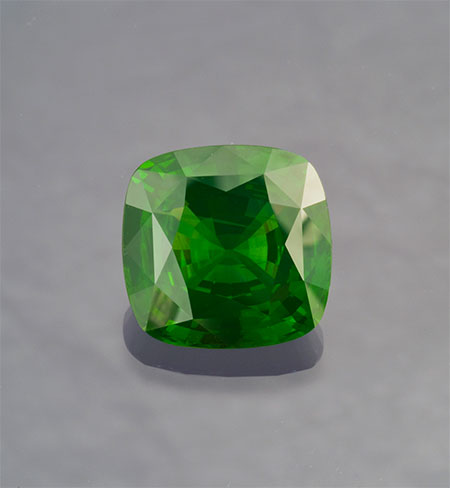 |
| Evergreen. Green zircon, 20.85 carats, cushion cut, 16.15 x 15.80 x 8.79 mm. This stone has been sold. (Photo: Mia Dixon) |
See also our Birthstones page.
Note: Palagems.com selects much of its material in the interest of fostering a stimulating discourse on the topics of gems, gemology, and the gemstone industry. Therefore the opinions expressed here are not necessarily those held by the proprietors of Palagems.com. We welcome your feedback.